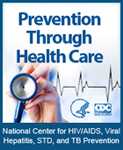Two New Promising Treatment Regimens for Gonorrhea
Press Release
For immediate release: Monday, July 15, 2013
Contact: National Center for HIV/AIDS, Viral Hepatitis, STD, and TB Prevention
(404) 639-8895
NCHHSTPMediaTeam@cdc.gov
Contact: National Institute of Allergy and Infectious Diseases
(301) 402-1663
NIAIDNews@niaid.nih.gov
Additional options urgently needed
Two new antibiotic regimens using existing drugs – injectable gentamicin in combination with oral azithromycin and oral gemifloxacin in combination with oral azithromycin – successfully treated gonorrhea infections in a clinical trial. The trial was conducted by the Centers for Disease Control and Prevention (CDC) and the National Institutes of Health (NIH). The study was conducted to identify new treatment options in the face of growing antibiotic resistance.
The findings will be presented this week by CDC’s Robert Kirkcaldy, M.D., at the 20th Meeting of The International Society for Sexually Transmitted Diseases Research (ISSTDR) in Vienna, Austria. Dr. Kirkcaldy served as the clinical trial’s principal investigator.
All drugs studied in the trial were Food and Drug Administration-approved and are available in the United States. This is the first clinical trial to evaluate them as combination therapy for gonorrhea.
Researchers found 100 percent effectiveness of the injectable gentamicin/oral azithromycin combination in curing genital gonorrhea infections, and 99.5 percent effectiveness of the oral gemifloxacin/oral azithromycin combination. Both combinations cured 100 percent of infections of the throat and rectum. However, many trial participants reported adverse effects from the drugs, mostly gastrointestinal issues.
“These trial results are an exciting step in the right direction in the fight against drug-resistant gonorrhea,” said Gail Bolan, M.D., director of CDC’s Division of STD Prevention. “But patients need more oral options with fewer side effects. It is imperative that researchers and pharmaceutical companies prioritize research to continue to identify new, effective, better-tolerated drugs and drug combinations.”
“In addition to developing new treatment options, additional measures to stay ahead of resistant gonorrhea are critical,” said Anthony S. Fauci, M.D., director of NIH’s National Institute of Allergy and Infectious Diseases (NIAID). “For example, a point-of-care drug susceptibility test would help providers know — at the time of diagnosis — which treatment regimen will be most effective. Progress toward a vaccine is urgently needed.”
NIAID sponsored the Phase IV clinical trial, which began in 2010 and enrolled 401 men and women ages 15 to 60 with untreated gonorrhea infection. The study was conducted at NIAID-funded clinical trial sites in Baltimore; Birmingham, Ala.; Los Angeles; Pittsburgh, Pa.; and San Francisco.
Of the 202 participants in the gentamicin/azithromycin arm, 28 percent experienced nausea, 19 percent experienced diarrhea and 7 percent experienced either abdominal discomfort/pain or vomiting. Of the 199 participants in the gemifloxicin/azithromycin arm, 37 percent experienced nausea, 23 percent experienced diarrhea, and 11 percent experienced abdominal discomfort/pain.
Today’s announcement does not change current gonorrhea treatment guidelines. CDC still recommends only one first-line treatment regimen: injectable ceftriaxone, in combination with one of two other oral antibiotics, either azithromycin or doxycycline. This regimen remains highly effective in treating gonorrhea and causes limited side effects. However, providers may consider using the regimens studied in this trial as alternative options when ceftriaxone cannot be used, such as in the case of a severe allergy. CDC is taking the findings of this trial into consideration for inclusion in future treatment guidelines.
Gonorrhea is one of the most common sexually transmitted diseases in the United States, where more than 800,000 gonorrhea infections are estimated to occur each year. Although some men and women may have symptoms (such as discharge or burning when urinating), most people infected with gonorrhea do not. As a result, many infections go undetected and untreated. Left untreated, gonorrhea can cause serious health problems, particularly for women, including chronic pelvic pain, life-threatening ectopic pregnancy, and infertility. Gonorrhea infection also increases a person’s risk of contracting and transmitting HIV.
It remains critical for people to take steps to protect themselves from gonorrhea infection. The surest way to prevent infection is not having sex. For those who are sexually active, consistent and correct condom use and limiting the number of sex partners can help reduce the risk of infection.
For more information about this clinical trial, see ClinicalTrials.gov using the identifier: NCT00926796.
For more information, visit CDC at: www.cdc.gov/nchhstp/newsroom or NIH at: http://www.niaid.nih.gov.
###
- Page last reviewed: July 15, 2013
- Page last updated: December 27, 2013
- Content source:


 ShareCompartir
ShareCompartir

